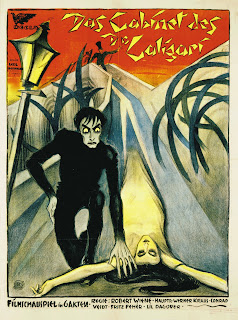It is immediately visible that Das Cabinet des Dr. Caligari,
despite being made in 1920, has had large influence in the arts. The stage like
composition in scenes such as when Francis and Jane are sat around her table are distinctly
Berkoffian, this vibe is furthered by the pale makeup and ham acting. Another
person it is clear has drawn inspiration from the film is Tim Burton; Cesare is
a timelessly designed character which is not too dissimilar from Edward Scissor
Hands. The way the scene where Cesare takes Jane across the rooftops (2) is composed- with false
warped depth and the jagged angles apparent throughout the film, also reminded
me of Burton and other surrealist modern directors. Many scenes in the film are
filmed at purposefully awkward angles it seems, this was sometimes slightly
unsettling and added further to the warped dream like world the film was set in
(which is of course in Francis’ own head). All buildings and many of the props
in the film were warped at awkward angles and were triangular in composition.
This was sometimes subtle and sometimes not so much so which gave the
impression of warped memory of the events as well as being in a surreal dream
world- and of course these were both true of the films story. The larger triangular structures and the
inintricasy of their decoration gave the impression of a warped art deco world,
way more aggressive than the art movement is usually. Especially inside Jane’s
house, where the patterns on the wall appear to be painted on messily (1). As the
film goes on, these patterns begin to appear in nature as well, on the floor
and on plants- as if the worlds in Francis’ head are merging as the action gets
more frantic. Other elements of the film are more delicately gaunt. In the
beginning scene where Jane is walking through the forest, the way the dead
trees contrast with the whites of her dress is more darkly romantic. The
coloured filters used for different scenes also added to the atmosphere, the
blues made the night time more sinister and the rusty sepia colour of the
flashbacks added to the surrealism. It is clear to see why this film has had so
much influence since it’s release.
(1) (2)



.jpg)
Well - would you look at that! Review 1 up and ready for Jackie's scrutiny... meanwhile, see link:
ReplyDeletehttp://ucarochester-cgartsandanimation.blogspot.co.uk/2013/09/cgaa-year-1-project-one-cinematic.html
Well done Livi - you've grabbed the bull by the horns and gone for it! :)
ReplyDeleteYou have made some really thoughtful observations here, and generally speaking this is a great start; what you need to do now (for your next review) is to make sure you back your ideas up with some quotes (you are asked to use 3 quotes)...have a look at what other people have written about the film, and in this way, you'll be able to develop your analysis in more depth. You could have a look in the library perhaps for German Expressionist cinema, or go online - Google Scholar is a good place to start. When you use a quote, don't just drop it in...make sure you introduce it in such a way that the reader is clear why you are using it, and then follow it up with an 'unpicking' that shows that you understand the reason for using it. Once you have your quote, you will need to make sure it is properly referenced - look here for information on how to reference both text and images
http://community.ucreative.ac.uk/article/27187/Referencing
There is a great, easy-to-read 'rough guide' to writing academically here -
http://myuca.ucreative.ac.uk/bbcswebdav/pid-243638-dt-content-rid-304615_1/courses/RCGA4002_13/Academic%20writing%20-%20Hints%20%26%20Tips.pdf
Just a reminder of the full requirements, as set out in the brief -
'Reviews of the ‘Space Oddities’ Film programme. Please note – in addition to
and support of your own critique, your reviews must include a minimum of 3
quotations from 3 different published sources6 + poster art + supporting stills.
Please note - Harvard Method must be used for all quotations and all illustrations to be referenced correctly. Reviews are to include bibliography and illustration list.'
Great start though!! :)